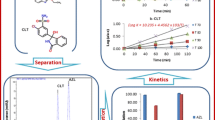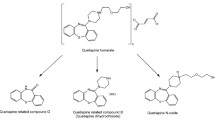Abstract
Ultra-performance liquid chromatography coupled with photodiode-array detection has been used to develop a simple, sensitive, and reproducible reversed-phase method for quantitative determination of fingolimod hydrochloride and all possible process-related impurities. Chromatographic separation was achieved on a Waters Acquity BEH C18 (100 mm × 2.1 mm, 1.7 µm) column. The mobile phase was a gradient prepared from potassium dihydrogen phosphate (20 mM) containing 0.1 % (v/v) triethylamine and adjusted to pH 6.5 with trifluoroacetic acid (component A) and 85:15 (v/v) acetonitrile–water (component B); the gradient program (time (min)/% B) was: 0.01/20, 2.0/20, 6.0/75, 9.0/90, 12.0/90, 14.0/20, 16.0/20; the run time was 16 min and fingolimod hydrochloride and its six impurities were well separated. Eluting compounds were monitored at 220 nm. The method was validated for precision, specificity, linearity, limit of detection, limit of quantification, accuracy, and robustness in accordance with International Conference on Harmonization guidelines. Fingolimod hydrochloride was subjected to oxidative, acid, base, hydrolytic, thermal, and photolytic stress, and analysis was conducted to determine the amounts of related impurities formed.




Similar content being viewed by others
References
Portaccio E (2011) Evidence-based assessment of potential use of fingolimod in treatment of relapsing multiple sclerosis. Core Evid 6:13–21
Aktas O, Kury P, Kieseier B, Hartung H-P (2010) Fingolimod is a potential novel therapy for multiple sclerosis. Nat Rev Neurol 6:373–382
Hussar DA, Zimmerman DE (2011) New drugs: dabigatran etexilate mesylate, fingolimod hydrochloride, and ulipristal acetate. J Am Pharm Assoc 51:122–126
Cohen JA et al (2010) Oral fingolimod or intramuscular interferon for relapsing multiple sclerosis. N Engl J Med 362:402–415
Swain J, Mohapatra M, Borkar SR, Aidhen IS, Mishra AK (2013) Study of aqueous phase aggregation of FTY720 (fingolimod hydrochloride) and its effect on DMPC liposomes using fluorescent molecular probes. Phys Chem Chem Phys 15:17962–17970
Wang J et al (2006) Synthesis of fingolimod. Chin J New Drugs 15:802–804
Feng X, Feng H (2012) Novel process for synthesizing fingolimod hydrochloride. Eur Patent EP2 502 901 A1
Kalyana Chakravarthy V, Gowri Sankar D (2011) LC determination of fingolimod in bulk and its pharmaceutical formulation. Imp J Med Org Chem 1(1):10–17
Swartz ME (2005) UPLC; an introduction and review. J Liq Chromatogr RT 28:1253–1263
Wren SAC, Tchlitcheff P (2006) Use of ultra-performance liquid chromatography in pharmaceutical development. J Chromatogr A 140:1119
ICH Q2(R1) (2006) Validation of analytical procedures, text and methodology. USFDA-Federal Register, USA
Ermer J (2001) Validation in pharmaceutical analysis, part 1: an integrated approach. J Pharm Biomed Anal 24:755–767
Ermer J, Ploss HJ (2005) Validation in pharmaceutical analysis, part II; Central importance of precision to establish acceptance criteria and for verifying and improving the quality of analytical data. J Pharm Biomed Anal 37:859–870
Author information
Authors and Affiliations
Corresponding author
Rights and permissions
About this article
Cite this article
Rajan, N., Anver Basha, K. Rapid Determination of Fingolimod Hydrochloride-Related Substances and Degradation Products in API and Pharmaceutical Dosage Forms by Use of a Stability-Indicating UPLC Method. Chromatographia 77, 1545–1552 (2014). https://doi.org/10.1007/s10337-014-2751-4
Received:
Revised:
Accepted:
Published:
Issue Date:
DOI: https://doi.org/10.1007/s10337-014-2751-4




